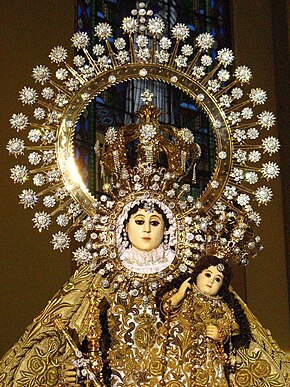Our Lady of La Naval de Manila
| Our Lady of the Most Holy Rosary of La Naval de Manila |
|
|---|---|
 |
|
| Location | Quezon City, Philippines |
| Date | 1593 - 1596 |
| Type | Ivory, wood statue |
| Holy See approval | 5 October 1907 by Pope Pius X |
| Shrine | National Shrine of Our Lady of the Most Holy Rosary, Santo Domingo Church, Quezon Avenue, Quezon City, Philippines |
| Patronage |
Philippine Navy Quezon City |
Our Lady of the Most Holy Rosary of La Naval de Manila (Spanish: Nuestra Señora del Santísimo Rosario de La Naval de Manila; Tagalog: Mahal na Ina ng Santo Rosaryo ng La Naval de Manila; colloquially known as Santo Rosario or Our Lady of La Naval de Manila), is both a title and an image of the Blessed Virgin Mary venerated in the Philippines. As with the Battle of Lepanto of 1571, Filipinos credit her intercession for successfully repulsing the Protestant Dutch invasion during the Battles of La Naval de Manila. Pious believers also credit the venerated image as the turning point for the country to remain as a bastion of Catholicism, famously claiming the victory of the country as "Pueblo Amante de Maria" or the beloved land of the Virgin Mary.
The image has been venerated by various Pontiffs, most notably by Pope Pius X, who granted the image a Canonical Coronation on 5 October 1907. In 2009, the Philippine government designated the image and its shrine as National Cultural Treasure of the Philippines making it one of the country's Cultural Properties.
Measuring at approximately 4' feet and 8" inches, the body is made of hardwood in the cage "Bastidor" type style while the face and hands, as well as the entire Child Jesus in its arms, are made of genuine ivory. Since its creation, the statue – considered the oldest dated ivory carving in the Philippines – has always been decorated with elaborate garments and a crown.
Some 310,000 individuals led by the professors of the University of Santo Tomas, donated their heirloom jewels, precious gems, gold and silver to the image for the Canonical Coronation of October 1907. These form part of the image's large collection of elaborate regalia, some of which date to the 1700s.
...
Wikipedia
